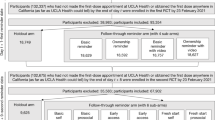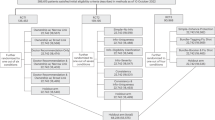Abstract
Background
Messages aimed at increasing uptake of vaccines have been modestly successful, perhaps in part because they often focus on why individuals should receive a vaccine. Construal Level Theory posits that messages emphasizing “how” to get a vaccine may be more effective at encouraging vaccination than emphasizing “why.” This message framing may be particularly important for COVID-19 booster acceptance.
Objective
To determine if pre-visit patient portal messages designed using Construal Level Theory increase rates of COVID-19 booster vaccination.
Design and Interventions
This 3-arm randomized trial was conducted across three large, diverse primary care clinics in Massachusetts between February and May 2022, testing the impact of “how” versus “why” framed pre-visit messages versus no messages (“usual care”). Messages were sent by patient portal two business days before a visit.
Participants
Adults with upcoming primary care visits who had electronic health record evidence of receiving their initial COVID-19 vaccination series but not a booster dose.
Main Measures
Receipt of a COVID-19 booster vaccination after the message was sent through the visit date (primary outcome) or 6 weeks (secondary outcome).
Key Results
A total of 3665 patients were randomized (mean age: 53.5 years (SD: 17.3), 59% female, 65.2% White, 26.6% Hispanic), with 1249 to “how” 1199 to “why,” and 1217 to usual care arms. Except for clinic and preferred language, characteristics were well balanced across arms. Rates of COVID-19 booster were 13.6% (usual care), 11.7% (“how”) (odds ratio (OR) “how” vs usual care: 0.87, 95%CI: 0.67–1.14), and 13.7% (“why”) (“why” vs usual care: OR: 1.01, 95%CI: 0.81–1.28). At 6 weeks, “why” outperformed “how” for vaccination (OR: 1.26, 95%CI: 1.06–1.49), with no difference versus usual care.
Conclusions
We found no differences on visit booster receipt after single pre-visit portal messages designed using Construal Level Theory. Further studies to identify effective messaging interventions are needed, especially as additional doses are recommended.
Clinical Trial Registration
This trial is registered at clinicaltrials.gov, ID: NCT04871776. Initial release occurred 04/30/2021.


Similar content being viewed by others
Explore related subjects
Discover the latest articles and news from researchers in related subjects, suggested using machine learning.References
Agaku IT, Adeoye C, Long TG. Geographic, occupational, and sociodemographic variations in uptake of COVID-19 booster doses among fully vaccinated US adults, December 1, 2021, to January 10, 2022. JAMA Netw Open. 2022;5(8):e2227680. https://doi.org/10.1001/jamanetworkopen.2022.27680.
Milkman KL, Patel MS, Gandhi L, et al. A Mega-Study of Text-Based Nudges Encouraging Patients to Get Vaccinated at an Upcoming Doctor’s Appointment. Social Science Research Network; 2021. https://papers.ssrn.com/abstract=3780267.Accessed 23 Feb 2021.
Reñosa MDC, Landicho J, Wachinger J, et al. Nudging toward vaccination: a systematic review. BMJ Glob Health. 2021;6(9):e006237. https://doi.org/10.1136/bmjgh-2021-006237.
Dai H, Saccardo S, Han MA, et al. Behavioural nudges increase COVID-19 vaccinations. Nature. 2021;597(7876):404-409. https://doi.org/10.1038/s41586-021-03843-2.
Jacobson M, Chang TY, Shah M, Pramanik R, Shah SB. Can financial incentives and other nudges increase COVID-19 vaccinations among the vaccine hesitant? A randomized trial. Vaccine. 2022;40(43):6235-6242. https://doi.org/10.1016/j.vaccine.2022.08.060.
Huf SW, Woldmann L, Crespo RF, et al. Implementing behavioural science informed letter interventions to increase COVID-19 vaccination uptake in uncontactable London residents: a difference-in-difference study in London, UK. Lancet Lond Engl. 2022;400 Suppl 1:S41. https://doi.org/10.1016/S0140-6736(22)02251-6.
Alhajji M, Alzeer AH, Al-Jafar R, et al. A national nudge study of differently framed messages to increase COVID-19 vaccine uptake in Saudi Arabia: a randomized controlled trial. Saudi Pharm J SPJ Off Publ Saudi Pharm Soc. 2023;31(9):101748. https://doi.org/10.1016/j.jsps.2023.101748.
Rodriguez RM, Nichol G, Eucker SA, et al. Effect of COVID-19 vaccine messaging platforms in emergency departments on vaccine acceptance and uptake: a cluster randomized clinical trial. JAMA Intern Med. 2023;183(2):115-123. https://doi.org/10.1001/jamainternmed.2022.5909.
Mehta SJ, Mallozzi C, Shaw PA, et al. Effect of text messaging and behavioral interventions on COVID-19 vaccination uptake: a randomized clinical trial. JAMA Netw Open. 2022;5(6):e2216649. https://doi.org/10.1001/jamanetworkopen.2022.16649.
Gollwitzer PM, Bayer U. Deliberative versus implemental mindsets in the control of action. In: Dual-Process Theories in Social Psychology. The Guilford Press; 1999:403–422.
Liberman N, Trope Y. The role of feasibility and desirability considerations in near and distant future decisions: A test of temporal construal theory. J Pers Soc Psychol. 1998;75(1):5-18. https://doi.org/10.1037/0022-3514.75.1.5.
Czeizler A, Garbarino E. Give blood today or save lives tomorrow: Matching decision and message construal level to maximize blood donation intentions. Health Mark Q. 2017;34(3):175-186. https://doi.org/10.1080/07359683.2017.1346430.
Keller PA. Chapter 2: Social Marketing and Healthy Behaviors. In: Stewart DW, ed. Handbook of Persuasion and Social Marketing. Routledge; 2015:9-38.
McCaul KD, Johnson RJ, Rothman AJ. The effects of framing and action instructions on whether older adults obtain flu shots. Health Psychol Off J Div Health Psychol Am Psychol Assoc. 2002;21(6):624-628. https://doi.org/10.1037//0278-6133.21.6.624.
Baskin E. Increasing influenza vaccination rates via low cost messaging interventions. PLoS ONE. 2018;13(2):e0192594. doi:https://doi.org/10.1371/journal.pone.0192594
Vaccine Hesitancy and Acceptance: Data Segmentation Helps Address Barriers. Published online February 8, 2021. https://images.healthcare.pressganey.com/Web/PressGaneyAssociatesInc/%7Bd9dfcd63-5405-468d-ae43-1ad0aaf0fe83%7D_2021_PG_WP_Vaccine_Hesitancy_and_Acceptance.pdf.Accessed 25 Feb 2021.
Malik AA, McFadden SM, Elharake J, Omer SB. Determinants of COVID-19 vaccine acceptance in the US. EClinicalMedicine. 2020;26:100495. https://doi.org/10.1016/j.eclinm.2020.100495.
Wason JMS, Stecher L, Mander AP. Correcting for multiple-testing in multi-arm trials: is it necessary and is it done? Trials. 2014;15. https://doi.org/10.1186/1745-6215-15-364.
Rothman KJ. No adjustments are needed for multiple comparisons. Epidemiol Camb Mass. 1990;1(1):43-46.
Szilagyi PG, Casillas A, Duru OK, et al. Evaluation of behavioral economic strategies to raise influenza vaccination rates across a health system: results from a randomized clinical trial. Prev Med. 2023;170:107474. https://doi.org/10.1016/j.ypmed.2023.107474.
Patel MS, Fogel R, Winegar AL, et al. Effect of text message reminders and vaccine reservations on adherence to a health system COVID-19 vaccination policy: a randomized clinical trial. JAMA Netw Open. 2022;5(7):e2222116. https://doi.org/10.1001/jamanetworkopen.2022.22116.
Batteux E, Mills F, Jones LF, Symons C, Weston D. The effectiveness of interventions for increasing COVID-19 vaccine uptake: a systematic review. Vaccines. 2022;10(3):386. https://doi.org/10.3390/vaccines10030386.
Funding
This research was supported by the National Institute on Aging of the National Institutes of Health under Award Number P30AG064199 to BWH (Choudhry PI). Dr. Lauffenburger (K01HL141538) and Dr. Haff (K23HL161480) were also supported in part by career development grants from the NIH. The content is solely the responsibility of the authors and does not necessarily represent the official views of the National Institutes of Health.
Author information
Authors and Affiliations
Corresponding author
Ethics declarations
Conflict of Interest:
Dr. Choudhry serves as a consultant to Veracity Healthcare Analytics and holds equity in RxAnte and DecipherHealth; unrelated to the current work, Dr. Choudhry has also received unrestricted grant funding payable to Brigham and Women’s Hospital from Humana. The remainder of the authors report no conflicts of interest.
Additional information
Publisher's Note
Springer Nature remains neutral with regard to jurisdictional claims in published maps and institutional affiliations.
Ms. Oran is now at Blue Cross Blue Shield of Massachusetts.
Rights and permissions
Springer Nature or its licensor (e.g. a society or other partner) holds exclusive rights to this article under a publishing agreement with the author(s) or other rightsholder(s); author self-archiving of the accepted manuscript version of this article is solely governed by the terms of such publishing agreement and applicable law.
About this article
Cite this article
Haff, N., Choudhry, N.K., Bhatkhande, G. et al. “How” Versus “Why” Messaging to Increase Uptake of Booster Vaccination Against COVID-19: Results of a Pragmatic Randomized Trial. J GEN INTERN MED 39, 611–618 (2024). https://doi.org/10.1007/s11606-023-08492-x
Received:
Accepted:
Published:
Issue Date:
DOI: https://doi.org/10.1007/s11606-023-08492-x




